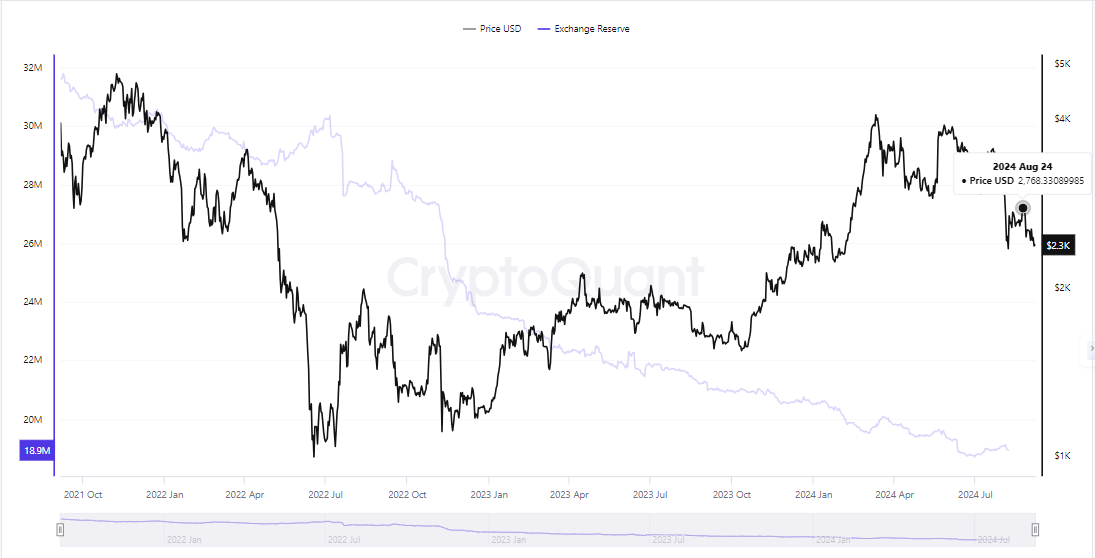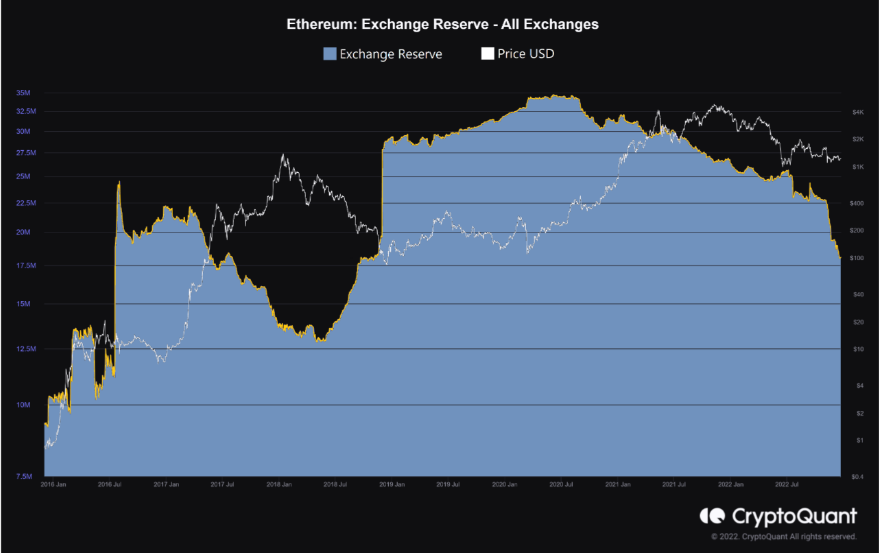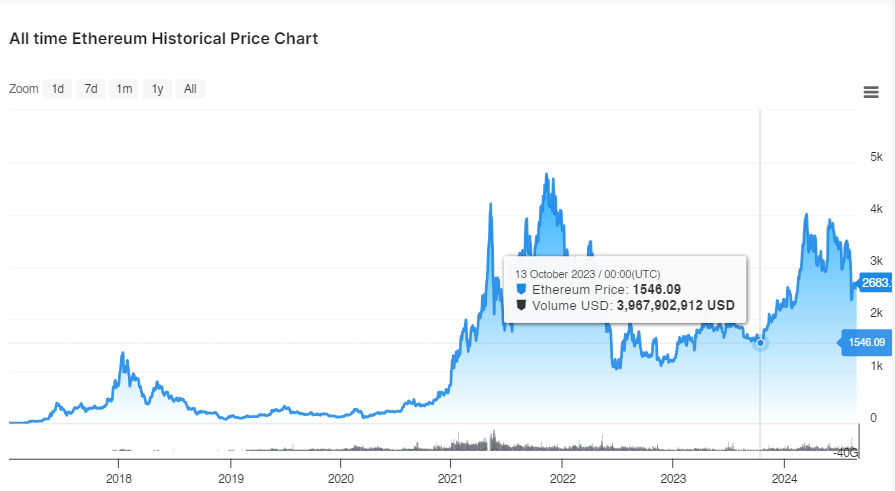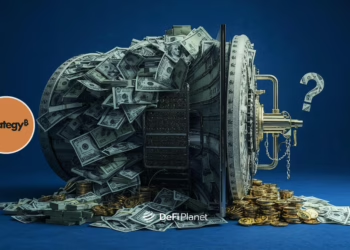Current State of Ethereum Exchange Reserves
Ethereum’s exchange reserves—the amount of the cryptocurrency held on exchanges, centralized or decentralized—have hit historic lows over the past few months.
Between May and June 2024, over $3 billion worth of Ether was withdrawn from centralized exchanges. Data from CryptoQuant shows that between May 23 and June 2, around 797,000 ETH were transferred out of exchange wallets. By July, however, Ethereum exchange reserves had dropped to their lowest levels since July 2016.
As a result, exchanges worldwide held only 16.9 million ETH, worth approximately $58.3 billion, a decrease of over 10% since the start of the year when exchanges had 18.8 million ETH worth about $65.0 billion.

This signals potential changes in investor behaviour and market dynamics.
Tracing the Evolution of Ethereum’s Exchange Reserves
Several factors may have contributed to this decline in exchange reserves. However, a historical context is crucial for understanding the current situation. The record lows we’re seeing now are not a sudden development but the result of a years-long trend influenced by technological developments, market events, and changing investor attitudes.
The evolution of Ethereum’s exchange reserves can be broken down into several key periods:
1. 2017-2018 Bull Run:
During this period, Ethereum’s exchange reserves initially increased. This was driven by two main factors:
- The cryptocurrency market as a whole was experiencing a significant bull run, with prices rising rapidly. This attracted many new investors to the market.
- The Initial Coin Offering (ICO) craze was at its peak. Many new projects were launching tokens on the Ethereum blockchain, and investors needed ETH to participate in these ICOs. This led to increased trading activity and more ETH being held on exchanges.

2. 2020-2021:
This period marked a trend shift. Despite Ethereum’s price rising significantly, exchange reserves began to decline. According to CryptoQuant, reserves dropped from 26.29 million ETH to 19.22 million ETH in 2021.
Several factors contributed to this:
- The launch of Ethereum 2.0 (now known as the Consensus Layer) in December 2020 introduced staking. Many investors moved their ETH off exchanges to participate in staking, earning rewards for helping secure the network.
- The growth of Decentralized Finance (DeFi) protocols on Ethereum provided new ways for investors to use their ETH productively rather than just holding it on exchanges.
- There was a growing sentiment among crypto investors about the importance of self-custody (“not your keys, not your coins”), leading more people to move their assets to personal wallets.
3. 2022 Bear Market:
The decline in exchange reserves continued and even accelerated during this period:
- The overall crypto market entered a bear phase, with prices declining significantly. However, instead of selling, many investors chose to hold onto their ETH, moving it off exchanges.ETH reserves fell by more than 30% by December 2022.
- The collapse of the then-biggest crypto exchange, FTX, in November 2022 shook investor confidence in centralized exchanges. This led to a significant outflow of assets, including ETH, from exchanges as investors sought the security of personal wallets.
4. 2023 Market Recovery:
As the market began to recover, a new dynamic emerged:
- The successful implementation of the Shanghai upgrade (also known as Shapella) in April 2023 allowed staked ETH to be withdrawn for the first time. Contrary to some expectations, this didn’t lead to a flood of ETH back onto exchanges. Instead, many chose to continue staking or holding in personal wallets. The official Ethereum staking address has kept growing since then; it held over 46.27 million ETH by June 2024
- Institutional interest in Ethereum grew significantly. Large investors and companies began accumulating ETH, often holding it in custodial solutions rather than on exchanges. This period saw institutions investing heavily in digital assets, with total investments surging by 176%, from $816 million in 2022 to $2.22 billion in 2023.
- The anticipation of spot Ether ETFs (similar to the Bitcoin ETFs approved in early 2024) led to further accumulation and withdrawal from exchanges. Peter Thiel’s firm reportedly invested $100 million in Ethereum, spurred by speculation surrounding the potential approval of a spot Bitcoin ETF in the U.S.

Throughout this evolution, we can see a general trend: despite fluctuations in Ethereum’s price and the broader market conditions, there has been a consistent move towards holding ETH off exchanges. This reflects changing investor behaviour, growing confidence in Ethereum’s long-term prospects, and the expanding utility of ETH in the broader ecosystem (staking, DeFi, etc.).
Future Outlook
The historic lows in Ethereum exchange reserves signal a potentially bullish future for ETH prices. Typically, when exchange reserves increase, it signals that holders are depositing their coins onto exchanges, often in preparation to sell.
With less ETH available on exchanges, the immediate selling pressure diminishes, setting the stage for a possible supply squeeze if demand surges. Also, the movement of ETH from exchanges to staking and DeFi protocols demonstrates strong investor confidence in Ethereum’s long-term value.
However, as with all cryptocurrency trends, the future remains uncertain and subject to various market forces and technological developments.
Disclaimer: This article is intended solely for informational purposes and should not be considered trading or investment advice. Nothing herein should be construed as financial, legal, or tax advice. Trading or investing in cryptocurrencies carries a considerable risk of financial loss. Always conduct due diligence.
If you would like to read more market analyses like this, visit DeFi Planet and follow us on Twitter, LinkedIn, Facebook, Instagram, and CoinMarketCap Community.
Take control of your crypto portfolio with MARKETS PRO, DeFi Planet’s suite of analytics tools.”




















